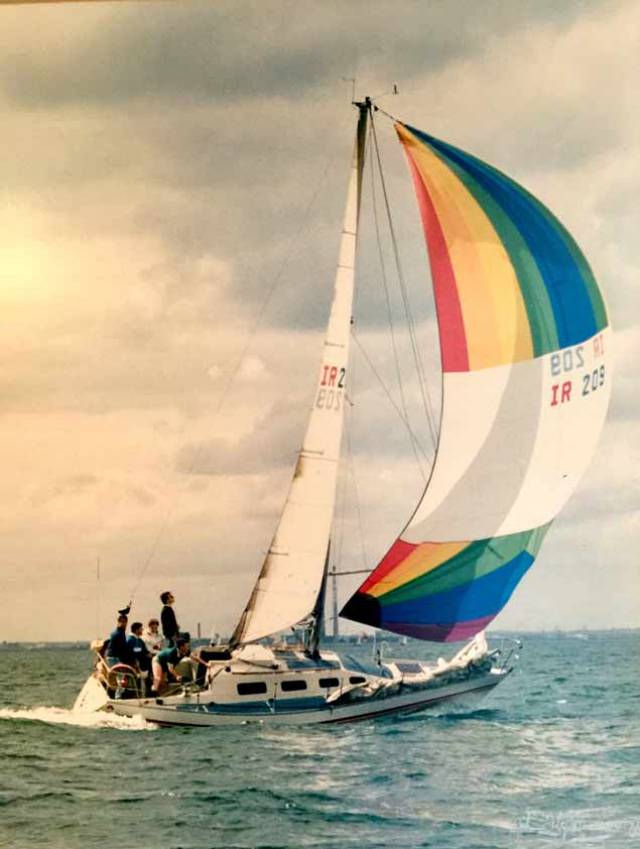“Peter Ryan of ISORA”. That’s all you have to say to anyone who knows anything of the Byzantine workings of the sailing scene in and around Ireland, and they’ll immediately know not only know exactly who you mean, but will almost as quickly have a vision of how well things can work when the right people are doing both the heavy lifting, and the clear thinking. W M Nixon shoots the breeze with a man who makes good things happen in sailing, and particularly in local offshore racing.
Peter Ryan’s life in sailing - and how he came into our sport in the first place - is instructive for those who would hope to establish an accessible structure with enticing programmes which get worthwhile newcomers engaged, and keep them engaged.
For he isn’t from a sailing family, and he hasn’t been through any formalized introductory and instruction sailing course. On the contrary, he’s from a classic Dublin family of publicans. The family house is Ryan’s of Beggar’s Bush, in which he still has a share, though we hasten to inform readers unfamiliar with Dublin that despite its name, the Beggar’s Bush neighbourhood is in Dublin 4, one of the city’s most affluent areas.
But as for this boy from Beggar’s Bush, he has spread his wings - professionally he’s now a leading Dublin-based chartered structural engineer, thanks to navigating his educational way through the Jesuits at Belvedere and the rather different yet still quintessentially Dublin atmosphere of Trinity College. And in sport, he has become one of the most quietly yet significantly influential figures in sailing.
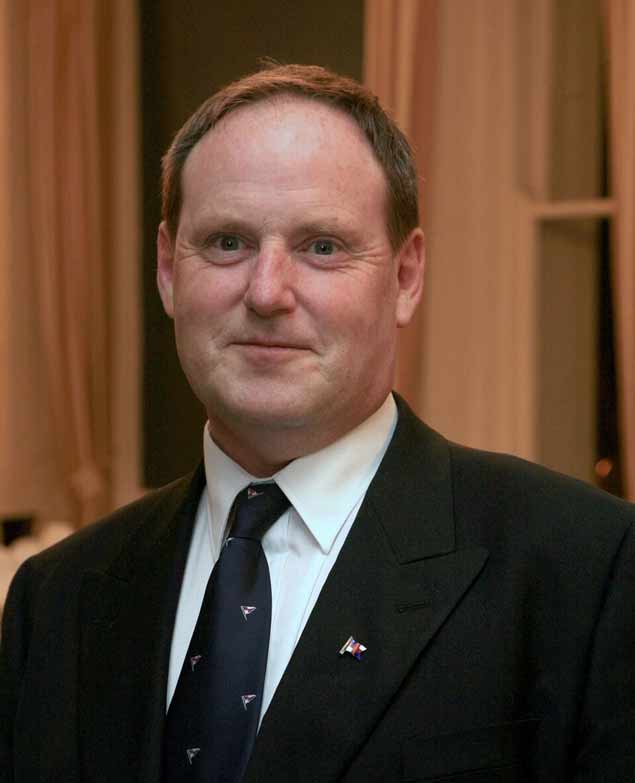 Peter Ryan on his election as Commodore of the National YC in 2008
Peter Ryan on his election as Commodore of the National YC in 2008
As he will be turning 60 in June this year – though he has the energy and continuing enthusiasm of someone twenty years younger – it can be quickly calculated that at the time of his youth, a proper Dublin family pub was a serious business, and fripperies like sailing would be way down the agenda. Yet he was sailing by the age of twelve, thanks to a school friend at Belvedere being Mark Cassidy, whose father Liam raced the 25ft Glen One-Design Glengesh out of the Royal St George YC with the Dun Laoghaire fleet.
However, it was not with regular DBSC racing that his interest was whetted – instead, it was a school vacation-time expedition with the Glens and the Dublin Bay 21s and others to Wicklow Regatta on the August Bank Holiday weekend, a complete experience with a spot of “offshore” sailing which introduced an observant schoolboy to many aspects – some of them good, some of them maybe quite not so good – of the Irish sailing scene.
He had by no means become a devoted sailor – at school he was “a reluctant Third Cs rugby player, but handy enough at cricket playing for Merrion in the summer, and Belvedere in term time”. But when he was courting Anne-Marie Horgan and her father Michael discovered the daughter’s new boyfriend had done a spot of sailing, he almost immediately roped the lad into crewing on his Flying Fifteen sailing out of the National Yacht Club, and Peter Ryan has been involved with the National – and the remarkable Horgan family – ever since.
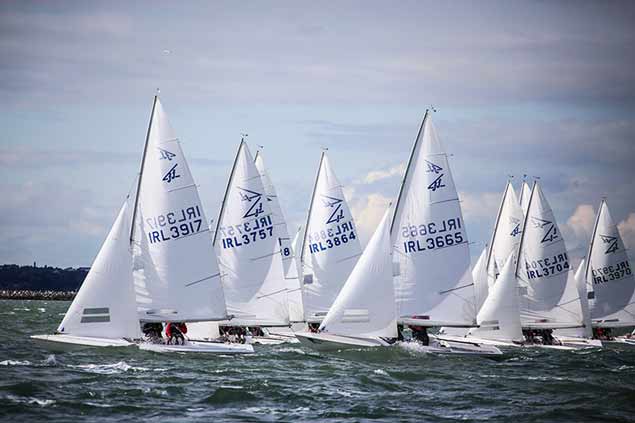 The Flying Fifteens in Dublin Bay provided Peter Ryan with his first real introduction to sailing. The National YC continues to be a stronghold of the class, and will be hosting the F/F Worlds next year.
The Flying Fifteens in Dublin Bay provided Peter Ryan with his first real introduction to sailing. The National YC continues to be a stronghold of the class, and will be hosting the F/F Worlds next year.
It’s timely here to reflect on how the Dun Laoghaire Flying Fifteen fleet has played a leading role in introducing people to sailing. Thanks to its little keel, a Flying Fifteen can provide what is otherwise almost the complete dinghy sailing experience without the inevitable capsize. For people who have never been through the Junior Training Programme, where learning how to handle a capsize is part of the curriculum, the Flying Fifteen is a Godsend, and for Peter Ryan it drew him ever more into sailing, and he went on to crew in the class for Richard Nolan.
On the educational side, he had been interested in studying chemical engineering at third level, but found that while his list of school qualifications best fitted the Trinity College requirements, the range of subjects available at TCD at that time simply didn’t include chemical engineering. However, he re-focused so neatly on the structural engineering course which was available that today it is difficult to imagine him doing anything else at a professional level.
Meanwhile, he was now thoroughly drawn into the life of the National YC, what with being on course to marry Anne-Marie Horgan in 1982 (their two children are now 30 and 21), continuing Flying Fifteens racing, and having his first taste of full-on keelboat racing with DBSC. So he cheerfully admits he began offshore racing when that renowned skipper Liam Shanahan came into the snooker room of the club and spotted a likely crew-member in young Ryan. In his early 20s at the time, he was signed on for an up-coming offshore race in Liam Shanahan’s newly-acquired db2S Lightning, and that was Peter Ryan hooked into the offshore game.
 The Dehler db2s. His first offshore race on Liam Shanahan’s Lightning gave Peter Ryan a livelong love of this side of sailing.
The Dehler db2s. His first offshore race on Liam Shanahan’s Lightning gave Peter Ryan a livelong love of this side of sailing.
The Shanahan and Horgan families were comfortable with each other in the time-honoured National YC way, and as Liam Shanahan found himself in a two-boat situation as he still had his well-campaigned Ron Holland-designed Club Shamrock Emircedes, it seemed entirely natural that in due course Michael Horgan and Peter Ryan should team up to buy Emircedes as the family boat, mainly for Dublin Bay SC involvement and a very active offshore racing programme, but also for the occasional bit of cruising.
They did so much sailing with Emircedes between the mid 1980s and her sale in 2004 that we could comfortably devote several articles to their achievements, but sufficient to say they were usually in the frame. And with Michael Horgan becoming Commodore of the National Yacht Club in 1993, and the club’s biennial Dun Laoghaire to Dingle Race being inaugurated that same year, the offshore programme was becoming very crowded for a keen crew, as Wicklow’s Round Ireland Race (in alternate years to the Dingle dash) had been increasingly popular since its inauguration in 1980, while the Irish Sea Offshore Racing programme – with IS0RA founded through a combination of organisations in 1972 - was also still trundling along, though not with the large entries it had known in the 1970s and ’80s.
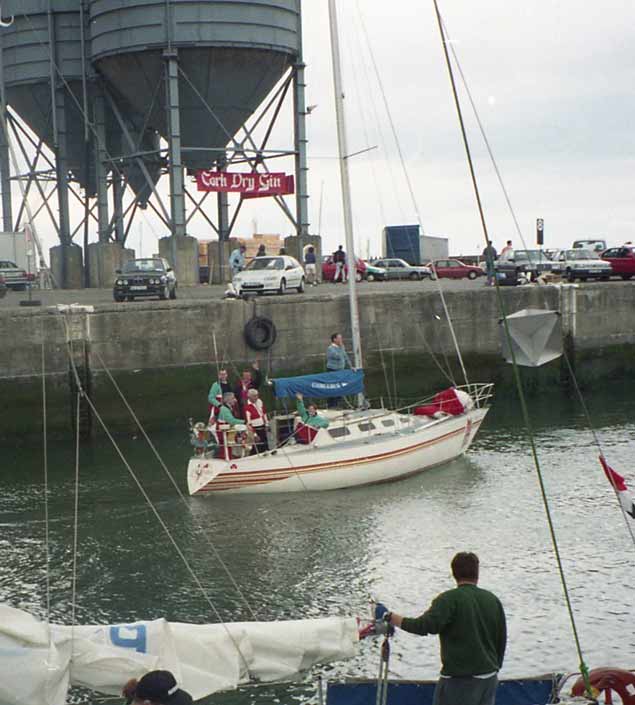 Emircedes (Michael Horgan & Peter Ryan) heading out of Wicklow port for the start of the 1994 Round Ireland race. Emircedes was one of the smallest boats in the fleet.
Emircedes (Michael Horgan & Peter Ryan) heading out of Wicklow port for the start of the 1994 Round Ireland race. Emircedes was one of the smallest boats in the fleet.
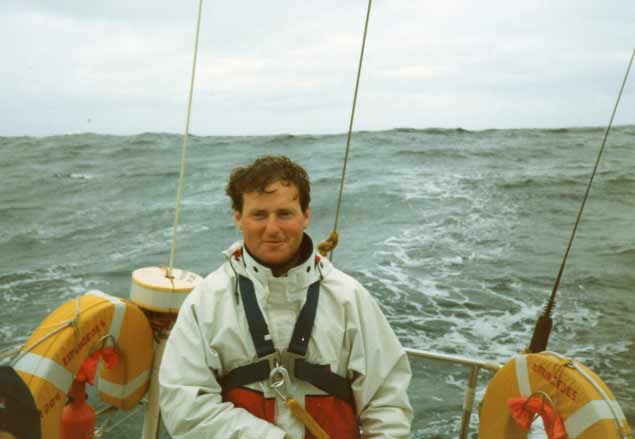 Small boat, big ocean – Peter Ryan enjoying helming Emircedes along Ireland’s Atlantic seaboard in the 1988 Round Ireland Race.
Small boat, big ocean – Peter Ryan enjoying helming Emircedes along Ireland’s Atlantic seaboard in the 1988 Round Ireland Race.
Despite that, there was something about ISORA which particularly appealed to Peter Ryan. He enjoyed the rhythm of its offshore races, and the idiosyncracies of each course. He was stimulated by facing the challenges that the weather and navigation of those diverse courses could provide. He cherished the cross-channel friendships the racing brought with it. He relished the opportunity to race against a fresh selection of boats, boats that he wouldn’t regularly see in the routine Dublin Bay Thursday evening racing. And he found something special in the way that any of the ISORA races which had started in Ireland would usually finish in Wales - though sometimes in the Isle of Man – thereby providing a rewarding way of going right to the heart of a new community.
But as different ways of enjoying leisure developed, and new expectations emerged of what family life entailed, a decline in local time-consuming offshore racing inevitably tended to see a falling away in ISORA numbers among the less-committed. It saddened him, but he was busy enough with the demands of the ever-more-crowded sailing and family programme based around Dublin Bay and the pillar offshore events, while his ability to get things done found him being targeted for one of the most demanding jobs in the voluntary sector of the National YC administration.
Boathouse Captain is a title with a certain ring to it, but properly done in those days, it was not so much a position of status as one of being in a demanding role, a real grind with much hands-on work to ensure the smooth working of the complex interface between the suave presence that a club like the National presents to the world at large, and the nitty-gritty of the way it helps to get its members afloat in boats large and small, plus how it serves their boats and moorings.
Peter Ryan was catapulted into this job for a three year stint in 2002 in the tough days before the National YC had a professional Sailing Manager. Although after a year or so he no longer had to deal with personal demands of boat-ownership and was to sail in due course with Vincent Farrell on the 2004 First 40.7 Tsunami, being Boathouse Captain was no sinecure. But with typical thoroughness he set to, quizzing the boatmen on how things were done, researching and implementing the improvements that were possible, and generally restoring the Boathouse functions to their central role in club waterfront life.
 Flying Fifteens and Wayfarer dinghies being brought ashore on the National YC slipway at the Volvo Dun Laoghaire Regatta in July 2017. As NYC Boathouse Captain from 2002-2005, Peter Ryan was directly involved in re-organising and modernising the club’s waterfront facilities and procedures. Photo: W M Nixon
Flying Fifteens and Wayfarer dinghies being brought ashore on the National YC slipway at the Volvo Dun Laoghaire Regatta in July 2017. As NYC Boathouse Captain from 2002-2005, Peter Ryan was directly involved in re-organising and modernising the club’s waterfront facilities and procedures. Photo: W M Nixon
He acquitted himself so well in the challenge that when Con Murphy became National YC Commodore in 2005, he brought in Peter Ryan as his Vice Commodore - a rocket-like promotion. Yet so highly were the new Vice Commodore’s abilities and achievements regarded that when he made an unusual request of the National YC Committee in the Autumn of 2005, they obliged him.
An extraordinary event – a wake of sorts - had been scheduled for the National YC in November 2005. Although Peter Ryan’s own enthusiasm for offshore racing was to be even further increased by the great joy of racing the First 40.7 Tsunami, interest in the annual ISORA programme was draining away so rapidly that the Chairman from the British side had decided that it was time to wind up the Association – he reckoned it had clearly outlived its usefulness.
A grand Farewell Dinner, black tie and all, was scheduled for the National YC in November, when some of ISORA’s 47 trophies would be given out to the few winners, while all the others would be returned where possible to the clubs or individuals who had donated them.
The totality of it came home to Peter Ryan when he saw the trophies being assembled in the weeks beforehand in all their historic glory. Some of them went back to races which were first sailed in the 1930s or even earlier. Yet somehow he’d a feeling that reports of ISORA’s demise were greatly exaggerated. And at a practical level, he realised that the re-assembly of the trophies in the event of a revival some time in the future would be an insurmountable task.
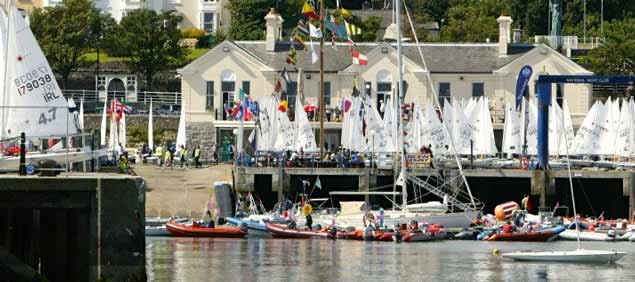 The National Yacht Club in Dun Laoghaire. Its Committee’s willingness to allow its office to be used as the base for ISORA saved the Association from being formally wound up in 2005.
The National Yacht Club in Dun Laoghaire. Its Committee’s willingness to allow its office to be used as the base for ISORA saved the Association from being formally wound up in 2005.
So he set about doing some groundwork to see if the National YC would be prepared to provide the administrative paperwork in those digital changeover days to keep ISORA ticking over, and he had this approval in place as D-Day for the Final Dinner approached. Then fate took a hand in an almost spooky way. An exceptional storm (even by Irish Sea late-autumn standards) meant no cross-channel ferries could sail. The funeral party from the English and Welsh contingents were unable to get across to Dun Laoghaire.
In their absence, the Irish contingent went ahead with the dinner. But it was emphatically no longer a wake. On the contrary, ISORA was re-born, and with Peter Ryan making an input with a realistic sense of what was possible, it has slowly revived ever since, and is now once again a nationally and indeed internationally-respected force in offshore racing.
 National YC Commodores at Peter Ryan’s end-of-term Commodores’ Dinner in 2011 are (back row, left to right) Brian Barry (1990), Michael Horgan (1993), Con Murphy (2005), Barry MacNeaney (1996), and Malachi Muldoon (1987). Front row Chris Moore (2002), Peter Ryan (2008-2011) and Ida Kiernan (1999).
National YC Commodores at Peter Ryan’s end-of-term Commodores’ Dinner in 2011 are (back row, left to right) Brian Barry (1990), Michael Horgan (1993), Con Murphy (2005), Barry MacNeaney (1996), and Malachi Muldoon (1987). Front row Chris Moore (2002), Peter Ryan (2008-2011) and Ida Kiernan (1999).
As for Peter Ryan, it was a case of a busy man getting ever busier. While quietly guiding the revival of ISORA with his effective mixture of under-stated determination and unrivalled knowledge of what the local offshore racing community requires from its sport, he had to continue for more than two years as NYC Vice Commodore, and then in 2008 he succeeded Con Murphy to take on the role of Commodore for three years as the great economic recession started to bite, with some of its most vicious effects reserved exclusively for Ireland.
But sailing life went on, albeit in muted style. Boats were still very much in being, even if they had to make do with sails no longer at their best. Yet as it happened, the fact that ISORA could provide accessible local offshore racing as economically as possible meant that its programme slowly revived and expanded despite the economic downturn.
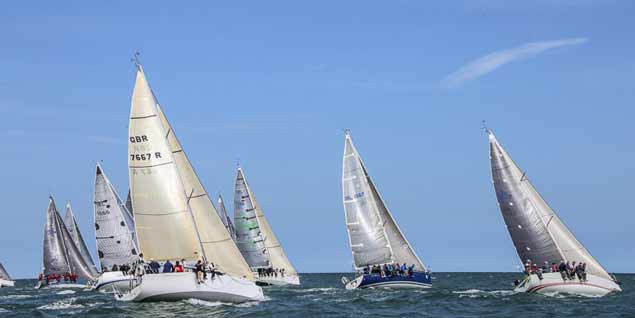 After the re-birth of 2005, ISORA numbers have been slowly but steadily increasing.
After the re-birth of 2005, ISORA numbers have been slowly but steadily increasing.
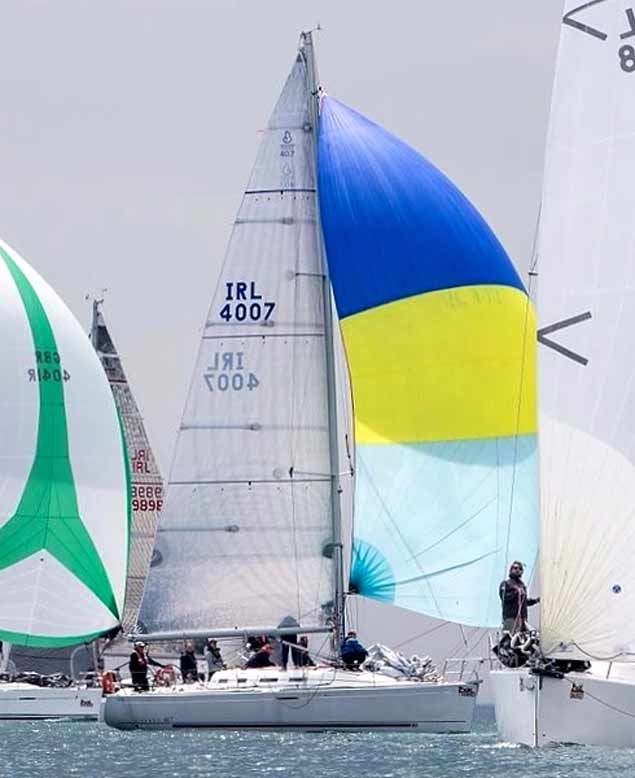 Vincent Farrell’s First 40.7 Tsunami, ISORA Champion in 2009 with Peter Ryan on board.
Vincent Farrell’s First 40.7 Tsunami, ISORA Champion in 2009 with Peter Ryan on board.
For Peter Ryan doing double duty as NYC Commodore and ISORA administrator, a very special year came in 2009 when he somehow found time to play a central role in Vincent Farrell’s First 40.7 Tsunami winning overall in the revived ISORA Championship in 2009. And though Tsunami has these days cut down on full-on offshore racing, Peter Ryan continues to campaign with her in DBSC and coastal races, while for the offshore stuff his growing treasure-hoard of cross-channel friendships has seen him filling regular crewing jobs on the Pwllheli-based J/109s Sgrech and Mojito, and he was on the strength of Sgrech for her overall victories in the 2012, 2013 and 2016 ISORA Championships.
 Stephen Tudor’s J/109 Sgrech, three times ISORA overall champion. He has a new J/111 for 2018.
Stephen Tudor’s J/109 Sgrech, three times ISORA overall champion. He has a new J/111 for 2018.
In fact, the role of the J/109s in the ISORA revival deserves praise – they were just what was needed when it was most needed, and duly received their reward. Stephen Tudor’s Sgrech won the championship from the Welsh side in 2012 and 2013, then Liam Shanahan Jnr’s Ruth from Ireland won in 2014 and 2015, while for 2016 and 2017 it has been back to Wales with Sgrech in 2016 and Vicky Cox and Peter Dunlop’s Mojito from Pwllheli (though they regard the National as their Irish home) who were feted at last November’s mega-dinner as the 2017 champions, albeit with the title being settled by the tiniest of margins in the final race.
Yet in all this friendliest of cross-channel rivalries, Peter Ryan’s extraordinary ability to get on with people and fit into a team has meant that he can transfer seamlessly from one boat to another. Thus although he was on the strength of Sgrech when she won the 2013 Championship, in that same year he also successfully participated in both the Dun Laoghaire to Dingle and Fastnet Races as a leading crewmember on Mojito.
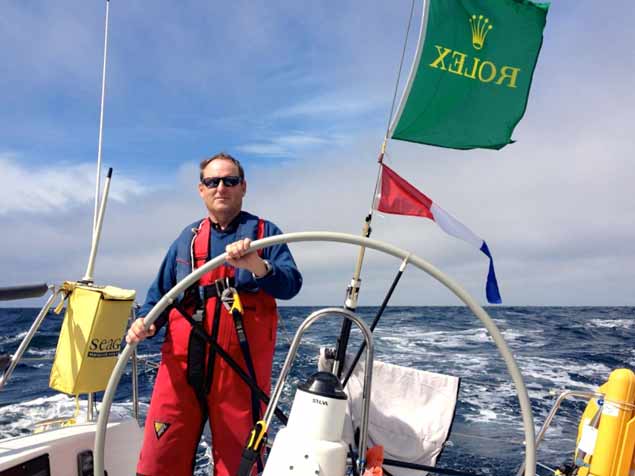 Dream sailing – fair winds and sunshine for Peter Ryan on Mojito’s helm in the 2013 Fastnet Race.
Dream sailing – fair winds and sunshine for Peter Ryan on Mojito’s helm in the 2013 Fastnet Race.
This breadth of experience helps to gives him a sort of sixth sense in gauging what ISORA crews expect from their programme, while he and co-administrator Stephen Tudor of Pwllheli (Peter is ISORA Chairman while Stephen is Secretary) have this almost telepathic relationship which enables ISORA to function effectively with a minimum of fuss through a programme which provides the maximum of racing with the least possible consumption of non-racing time.
 Stephen Tudor of Pwllheli – he and Peter Ryan are in tune on offshore racing. Photo: W M Nixon
Stephen Tudor of Pwllheli – he and Peter Ryan are in tune on offshore racing. Photo: W M Nixon
The Pwllheli skipper – in addition to his almost fanatical devotion to the cause of promoting his home port and the clear waters of Tremadoc Bay as a major sailing location – is renowned for his ability to maximize computer effectiveness. Thus we have this ten year parable for our time, whereby ISORA was saved in 2005 because the National YC was prepared to take on its administration through paperwork, but by 2015 it was thriving extremely efficiently because a successful owner-skipper in Pwllheli has a genius for modern computer-generated communication.
Yet that said, the old-fashioned ability to put a coherent account together immediately after the event is another key to ISORA-awareness, and Peter Ryan will willingly buckle down personally, and produce a report which speaks to participants and followers alike. It’s one of the many techniques he quietly employs to keep people interested, and think keenly of doing the next race in the series.
But all these management and communication skills would be much less effective were it not for the fact that Peter Ryan and Stephen Tudor are never happier than when they themselves are out racing offshore. They lead and inspire by example. Their quiet persuasion is underpinned by hugely-enjoyed action.
All that goes some way to explain why, just a dozen years after a dinner had been scheduled in the National Yacht Club for the doleful marking of the supposed demise of ISORA, in November 2017 Peter Ryan organised a joyful prize-giving dinner for 240 people from both sides of the channel at the same venue to celebrate a great ISORA year, and award those prizes which, back in 2005, had almost been scattered to the four winds.
 The Champion. 2017 ISORA overall winner Mojito in perfect racing trim
The Champion. 2017 ISORA overall winner Mojito in perfect racing trim
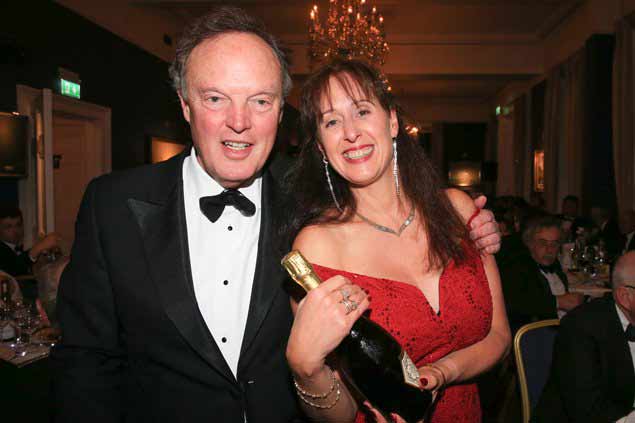 At the record-breaking November 2017 ISORA Prize-giving Dinner in the National YC, RORC Commodore Michael Boyd (left) was Guest of Honour to see Vicky Cox (right), co-owner of Mojito with Peter Dunlop, receive the overall champion’s prize. With an attendance of 240, this 2017 dinner was in marked contrast to an event just a dozen years earlier, when it was originally intended to wind up ISORA.
At the record-breaking November 2017 ISORA Prize-giving Dinner in the National YC, RORC Commodore Michael Boyd (left) was Guest of Honour to see Vicky Cox (right), co-owner of Mojito with Peter Dunlop, receive the overall champion’s prize. With an attendance of 240, this 2017 dinner was in marked contrast to an event just a dozen years earlier, when it was originally intended to wind up ISORA.
It may have been a deservedly boisterous celebration. But behind the scenes, it has all been brought about through dogged belief in an ideal, and quiet persuasion with a keen sense of what is possible and what works best. It’s effective offshore racing without fuss. The ISORA Programme 2018 gets under way in a week’s time, and our sailing scene would be greatly diminished without it.



























